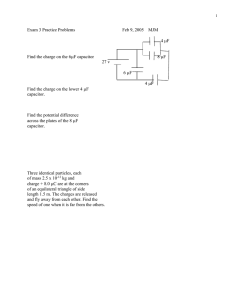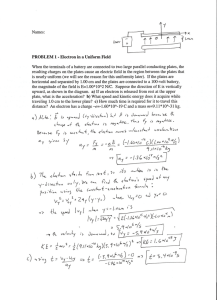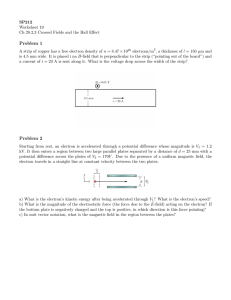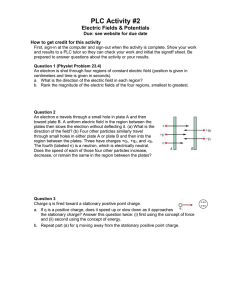Electric Deflection of Electrons
advertisement
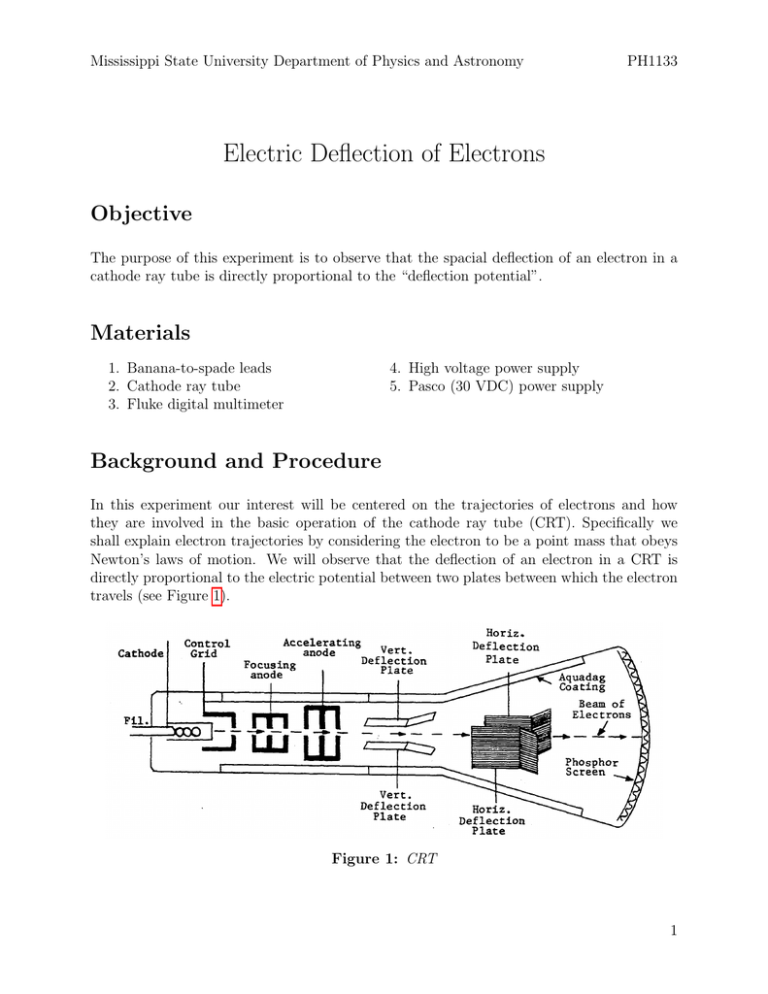
Mississippi State University Department of Physics and Astronomy PH1133 Electric Deflection of Electrons Objective The purpose of this experiment is to observe that the spacial deflection of an electron in a cathode ray tube is directly proportional to the “deflection potential”. Materials 1. Banana-to-spade leads 2. Cathode ray tube 3. Fluke digital multimeter 4. High voltage power supply 5. Pasco (30 VDC) power supply Background and Procedure In this experiment our interest will be centered on the trajectories of electrons and how they are involved in the basic operation of the cathode ray tube (CRT). Specifically we shall explain electron trajectories by considering the electron to be a point mass that obeys Newton’s laws of motion. We will observe that the deflection of an electron in a CRT is directly proportional to the electric potential between two plates between which the electron travels (see Figure 1). ! Figure 1: CRT 1 Mississippi State University Department of Physics and Astronomy ! PH1133 Figure 2: Typical Focusing Action Figure 1 shows a typical construction of a CRT. Electrons emitted from a heated cathode are accelerated toward an anode. Actually, for focusing purposes, more than one anode is used as illustrated by Figure 2. Figures 1 and 2 are not precise drawings of the 3BP1 CRT used in this experiment. The control grid in Figure 1 is only for the purpose of regulating the density of the electron beam and does not enter into calculations in this experiment. An electron is accelerated along the axis of the CRT from the cathode to the last anode through a difference in potential Vacc = VC + VB ; thus the work done on it is eVacc , where e is the charge of the electron. This work is the change in kinetic energy, and because the electron started from rest, the final kinetic energy is 1 2 mv = 1eVacc 2 z (The axis of the tube is taken as the z-axis, and Vacc accelerates the electron only along the z-axis, thus vx and vy are taken to be zero.) From this the emerging speed may be computed if other quantities are known. The electron enters the region between the deflection plates; it has an electric field directed toward the negative plate. E= Vdef d While the electron is between the plates there is an electric force directed toward the positive plate with a magnitude of F = eE Consequently its acceleration is given by Newton’s second law: a= F eE = m m This acceleration is, of course, towards the positive plate. The electron is given a lateral component of velocity vx vx = at1 2 Mississippi State University Department of Physics and Astronomy PH1133 ! Figure 3: Deflection where t1 is the time while between the plates t1 = ` vz and is displaced laterally an amount x1 1 x1 = at21 2 After emerging from between the plates the electron, no longer in the electric field, travels at constant velocity to the screen, and because of a lateral component of velocity, it continues to be displaced laterally an additional amount x2 x2 = vx t2 where t2 is the transit time to the screen t2 = L vz The total lateral displacement is, of course, x = x1 + x2 Equipment Setup The electrical connections are shown schematically in Figure 4 and pictorially in Figure 5. The deflecting plate leads are labeled x and y for horizontal and vertical. Both sets of plates produce deflections perpendicular to the tube axis that was labeled the z-axis above. We will use the horizontal deflecting plates in this experiment. The vertical plates are grounded 3 Mississippi State University Department of Physics and Astronomy PH1133 to prevent an unwanted buildup of charge. Reverse the x connector to change the direction of deflection (note the resistors are already attached to the connectors). The resistor in the cathode lead and the connection between terminals 2 and 3 are actually in the tube base rather than inside the glass tube itself. IMPORTANT: If the regulated power supply that you are using does not look like the one at the top of Figure 5, check to see if it is Model No. IP-32. If it is, use the connections indicated at the lower left of Figure 5. The filament leads (yellow wires) must be connected to the 6.3-volt AC supply. Note that C+ is internally connected to B−. Also note that each set of deflection plates and B+ are grounded. After you make the electrical connections, turn the regulated power supply on to standby for about a minute while the cathode heats before turning to the DC on position. With the B supply somewhere above halfway on the range adjust the DC supply for a sharp, well-focused spot. The deflecting potential should be on zero while you are doing this. Notice that the spot is not at the center of the screen. The reason for this will be brought out in a later experiment. For the time being measure all displacements from this spot. Record Vacc (= VC +VB ) (use the meter-select switch to have the meter indicate the voltage of interest) and record the displacement on the screen for several different deflecting potentials up to the maximum amount in each direction. Unfortunately the marks on the screen of the CRT are in inches and, therefore, should be changed to metric units where detailed calculations are made, as in Part I of the analysis. In construction most cathode ray tubes have deflection plates which are flared at the rear rather than parallel as in the above discussion. The final results are quite similar but precise computations are more complicated; so we shall, continue with the parallel plate equivalent. For purposes of calculations use the following values for the 3BP1 CRT: ` = 2 cm, d = 0.55 cm, L = 11.8 cm and, of course, the charge and mass of the electron are e = 1.6 × 10−19 coulomb; m = 9.1 × 10−31 kg. Analysis Part I The following computations illustrate particle properties of the electron. For one deflecting potential in your data compute the 1. speed of the electron as it enters the region between the plates, 2. electric field between the plates, 3. acceleration of the electron while between the plates, 4 Mississippi State University Department of Physics and Astronomy PH1133 ! 4. 5. 6. 7. 8. time between the plates, lateral velocity as it emerges from between the plates, lateral displacement as it emerges from between the plates, time to go from the plates to the screen, additional displacement while traveling from the plates to the screen, 5 Mississippi State University Department of Physics and Astronomy PH1133 9. total lateral displacement. Is your computed displacement consistent with your measured displacement? Which do you trust most? Comment: The above computations may be carried out in symbols to give total lateral displacement Vdef ` ` +L x= 2Vacc d 2 Part II Plot deflection versus deflecting potential and comment on the significance of the shape of the plot. Is your plot consistent with the equation above? Determine the deflection sensitivity (deflection per unit deflecting voltage). 6 Last Modified: July 21, 2014

